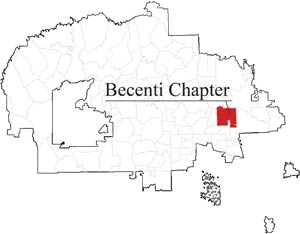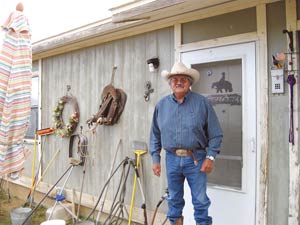The burbs of Crownpoint
Becenti has become a bedroom community for larger towns
By Cindy Yurth
Tséyi' Bureau
BECENTI CHAPTER, N.M., October 18, 2012



(Times photo — Cindy Yurth)
Abel Becenti thinks he may be a descendant of the chapter's namesake, but he isn't sure. He moved to the NHA cluster housing on a hilltop years ago, but misses living on his family plot and often goes back to check on the livestock.
For having a chapter named after him, not many people seem to know much about him.
"Maybe, somewhere along the line," muses Abel Becenti, 58, asked if he is related to the chief and first chapter president.
Charlotte Charley knows Chief Becenti was her great-great uncle, but other than that, all she knows is what anyone can learn on the chapter's website: that the chapter is named after him.
"We never talked about him in the family," she said. "Maybe it's that Navajo thing of not speaking about the dead."
The chief, if he ever was prominent in the public imagination, has faded from memory. Today, the most famous possible resident of Becenti Chapter is the creature known in Crownpoint as "The Howler."
Ruby Morgan, 63, says a lot of folks believe that whatever keeps area residents up at night in the summer with its lonely moan lives somewhere between Crownpoint and Becenti.
The barren, wash-veined land certainly looks like monster country, especially with Halloween approaching.
"My sister's a police officer, and she believes in it," Morgan declares. "A lot of people's dogs disappear around here."
The NHA development where Morgan lives with her 9-year-old grandson, Aven Begay, is on a lonely, windswept hill seven miles from Crownpoint, 66 miles from Farmington and 62 miles from Gallup.
There is not a single business; even the main chapter administration building is in Crownpoint. Chief Becenti himself is no longer here; he's buried in Gallup. According to Abel Becenti, most folks have big freezers and make a trip to Farmington every two weeks for groceries and errands, combining the day with a meal out and maybe a movie.
It's a hassle, but Morgan remembers when it was a lot tougher.
"Just from my family's house, about four miles from here, to Crownpoint was a five-and-a-half-hour wagon ride," she said. "Usually we'd do it all in one day."
Firewood was another matter – an all-day wagon ride to mountains barely visible on the horizon.
"We had to make that trip about 16 times a year," she said. "And when the roads were muddy, getting stuck was a real danger."
One of the area's Navajo names, "Tloodi Tsin," indicates it has been barren of trees for a long time, but other names, such as Tsin Neez Chooz and Tsin Yaa Naalk'd indicate there may once have been forests here, according to the chapter's website.
Another name, Jadi Hadi T'iih, "Antelope Lookout," reveals one reason people settled in these barren crags, besides the beautiful artesian spring.
"People used to go up there," Morgan said, indicating a rocky crag where the water tower is now, "and watch for antelope."
When they saw them, they would drive the herd up the hillside and over the cliff on the steep side, then harvest the bodies for meat and the horns for implements and ceremonies.
Becenti said you could still see small herds of pronghorn when he was a kid, but he hasn't seen any out here in years.
By the time Morgan was growing up, the people had transitioned from hunting to ranching, living in scattered compounds.
These days most families have moved into the NHA development, but Morgan says that, ironically, folks were more neighborly before.
"People used to help each other for free," she reminisced. "They used to go visit each other in the wagon. They used to love to share meat and vegetables with their neighbors. Now we all live together, but we don't do that."
One thing the 500-some souls in Becenti do have plenty of, at least when The Howler isn't howling, is quiet. That's how they like it.
"Everyone knows each other," said Charley.
"Yeah, it's nice," chimes in her friend, Tashina Kalleco, 22.
The chapter still has its original 1939 chapter house (it actually predates the establishment of the chapter, but was used for public meetings even before the chapter was created in 1955). But it's becoming a magnet for vandals.
"I wish they'd build a fence around it," sighed Becenti. "A lot of the older people have good memories of that building."
And there are good things about being devoid of trees. You can see forever.
Notes Charley, "The sunsets here are really great."
Just, after the sun goes down, watch out for The Howler.
Becenti at a Glance
Name -- Named after Chief Becenti, 1880-1936, a local leader. Navajo names for the area include "Tloodi Tsin" ("Barren of Trees") and "Jadi Hadi T'iih" ("Antelope Lookout")
Population — About 500
Area — 302 square miles or 193,752 acres
Historic building — The three-room, native stone meeting house was built in 1939 and became a chapter house when the chapter was recognized by the Navajo Nation in 1955. The current chapter house was built in 1960 and renovated in 1989.
Claim to fame — Some locals believe "The Howler," popularized by the "Navajo Cops" TV show, lives somewhere between Becenti and Crownpoint.

